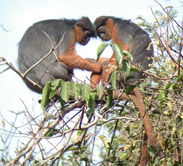What's for dinner? Let instinct guide you
What's for dinner? Let instinct guide you McGill University
User Tools (skip):
What's for dinner? Let instinct guide you

Red colobus monkeys
Oh, the delight of reading an extensive restaurant menu: the potential bounty laid out before the diner in a imagined banquet to tickle any culinary whim. But what to eat? For the endangered red colobus monkey, "what to eat" is simply a matter of instinct.
For the past 15 years, Colin Chapman, jointly appointed in the Department of Anthropology and the McGill School of the Environment, has been studying monkeys in the Kibale National Park in Uganda, home to one of the highest primate densities in the world. However, the abundance of populations and quality of habitats vary widely in Kibale because of the logging that occurred in some areas before it was designated a national park in 1993. This makes for an ideal ecosystem for Chapman to study.
"Ninety-six primate species are classified as critically endangered or endangered and Kibale is one of the few places left in East Africa where we find healthy populations. However, because we also see areas with low numbers, it is a very important place for learning about the factors that influence abundance," says Chapman.
Chapman spends summers in Uganda observing 12 different colobus groups in various habitats. He discovered that protein, not calories, is most important for species abundance. This is old news for the red colobus, which shows an instinctive preference for protein-rich leaves.
Observation allowed Chapman to determine that the red colobus concentrates its foraging efforts on the leaves of a specific tree, Celtis durandii, known as the false white stinkwood. Nutritional analysis revealed that its leaves contain 35 percent protein, approximately double that of other plants. The monkey groups with the highest populations were those whose habitats contained the greatest density of Celtis durandii.
This information can be a powerful tool for park managers, who are aiming to promote the long-term survival of the endangered red colobus. With growing human numbers and a corresponding pressure on monkey habitats, such knowledge is more important than ever.
It should be easy to spread the word, though. The current head of national parks in Uganda is one of Chapman's former students. The anthropologist believes that training graduate students from both Ugandan universities and McGill is a top priority.
WARM-SPARK (Writing About Research at McGill-Students Promoting Awareness of Research Knowledge) is a program sponsored by the Faculty of Science, the Offices of the Vice-Principal (Research) and University Relations, NSERC, the Faculty of Engineering and the Faculty of Agriculture and Environmental Sciences. See www.spark.mcgill.ca for more information and articles.
